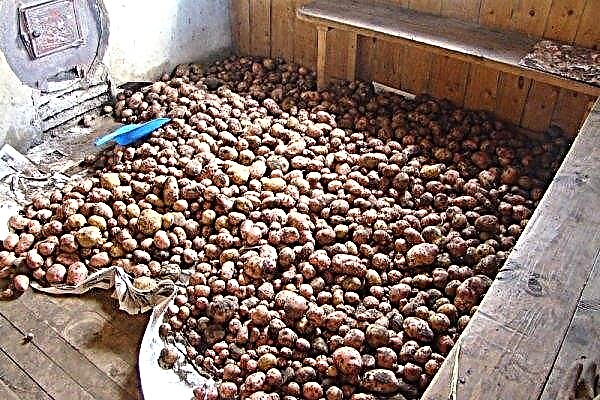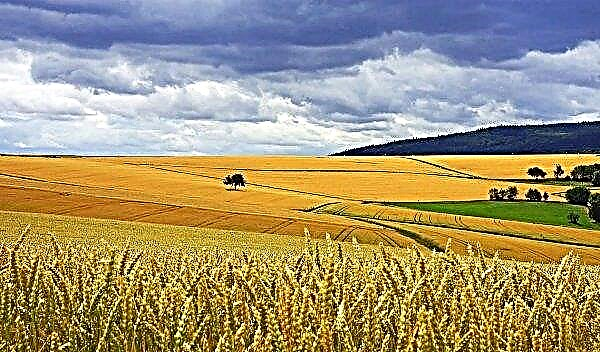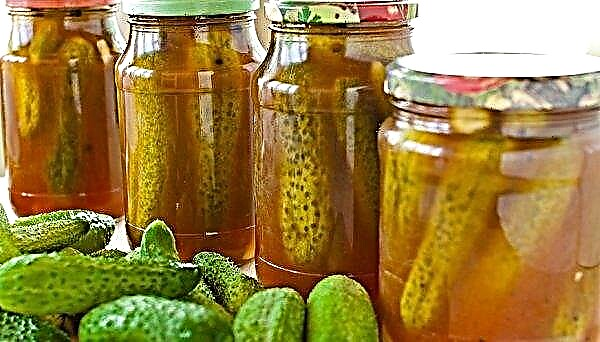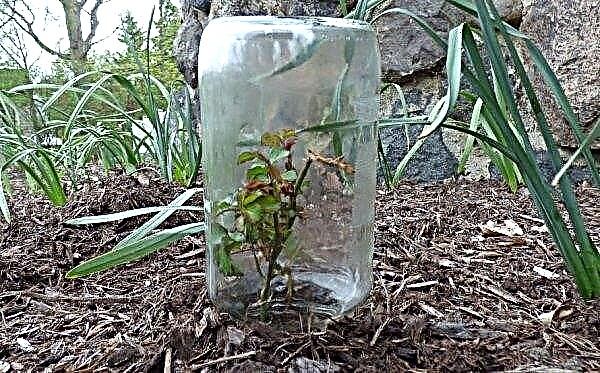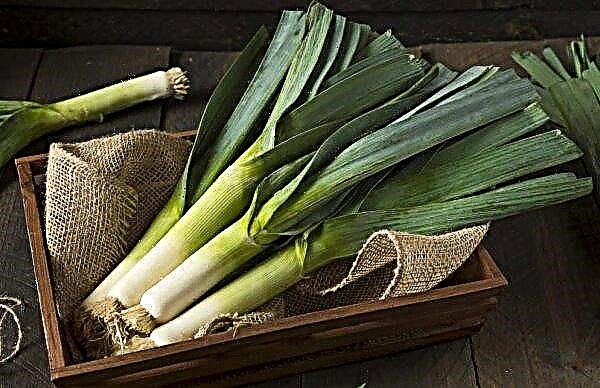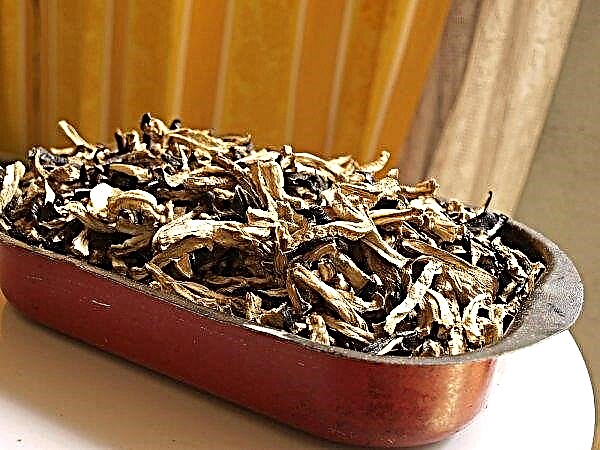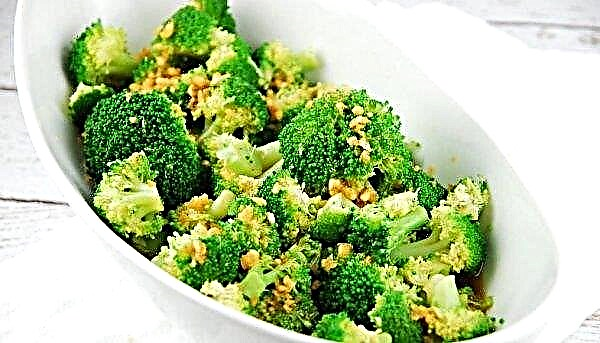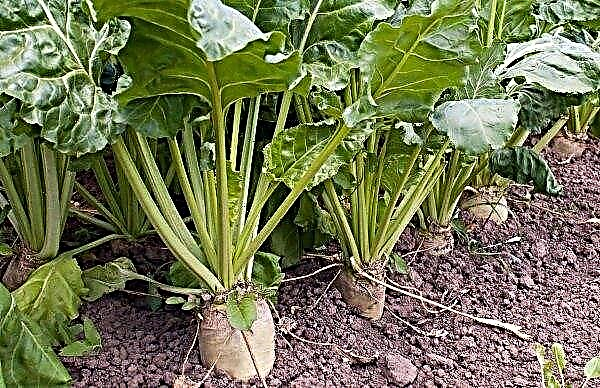The quantity and quality of the resulting garlic crop depends on the correct planting. Spring sowing is significantly different from winter sowing and is characterized by greater efficiency. Consider the basic rules of agricultural technology when planting spring garlic.
Benefits of Spring Planting
- The main advantages of spring planting:
- harvesting a long shelf life;
- friendly shoots;
- minimizing the risks of losing crops due to return frosts.
Did you know? Garlic emits volatile substances - volatile, which are a natural antibiotic. With their help, the plant protects itself from pathogens. These properties are used in medicine. During the epidemics, the Old Slavic peoples made special garlic garments, which were worn around the neck. Phytoncides, penetrating into the lungs together with air, act on the body, like modern inhalation agents.
The best varieties of spring garlic
You need to start by choosing the right variety. Consider the best options:
- Abrek - high-yielding variety of medium maturity. Gives a crop in the form of a flattened bulb weighing 30 g, consisting of 15 cloves, does not form an arrow. The pulp is dense, sharp in taste. Products retain their quality for 7 months.

Victorio - mid-season non-shooting variety. Pear-shaped heads consist of 13–15 large cloves, weigh 45 g. The pulp is dense, white, and medium sharp.

Gulliver - lancet, mid-late variety. Large heads weigh 100–120 g each and consist of 3-5 cloves. Giant specimens reach a weight of 250 g. The flesh is white in color, has a dense structure, crisp, burning, sharp.

Cledor - Elite non-shooting grade. The heads consist of 20 teeth arranged spirally. They weigh 30–40 g. The pulp is dense, cream-colored, and gently sharp. Harvest does not lose quality for 10 months.

- Permyak - medium-ripening variety, suitable for cultivation in the northern regions. Pear-shaped heads consist of 17 teeth of complex structure. Each weighs 34 g. The flesh is white, medium sharp.

How to plant garlic with cloves in spring
A properly prepared site and the selection of high-grade planting material can achieve high results. Garlic does not tolerate too close proximity. The distance from the garlic plantings to the nearest crop should be at least 40 cm.
Important! Garlic must be waged as a three-year-old culture. In the first year, in the spring, garlic is planted on the head, in the second - they put a single tooth, in the third - a clove. Annual planting with cloves leads to a decrease in crop quality. If the head weighs on average 100-120 g, then with the annual germination of the cloves for the third year, the mass will decrease by 50%.
When to plant
Planting is carried out when the soil warms up to +5 ° C. Planting dates - from March 15 to May 25, depending on the climate of the region. It is important to wait until the danger of return frost has passed and the average daily temperature will be +15 ... + 20 ° C.
Favorable days for planting garlic in the spring, according to the lunar calendar for 2018:
- March 22–25;
- April - 4th, 5th, 20th, 21st;
- May - 18–20.
Choosing a place to land
Garlic develops best on loamy soils and chernozems with a neutral acidity level of up to 6 pH. With an increase in acidity, the culture begins to hurt. Garlic culture prefers well-lit, sun-heated areas.
Garlic should not be planted in the same place for 2 years in a row. You can return it to its previous site after 3 years.
The plant develops well in the territory where it grew:- winter crops;
- raspberry;
- legumes;
- cabbage;
- gooseberry;
- Strawberry.
 Adverse predecessors and neighbors:
Adverse predecessors and neighbors:- potatoes;
- bow;
- winter garlic;
- solanaceous.
Site preparation
Preparatory procedures on the site are carried out 2 weeks before planting and include the following activities:
- harvesting weeds;
- composting of 10 kg per square meter. m;
- digging 20 cm deep;
- fertilizer with saline for 2 days of planting (3 tbsp. l. salt per 10 l of water).
 With increased acidity, the plot is fertilized with lime at 10 kg per square meter. m in autumn, at low - make wood ash of 5 kg per square. m
With increased acidity, the plot is fertilized with lime at 10 kg per square meter. m in autumn, at low - make wood ash of 5 kg per square. mSelection and preparation of planting material
Planting material is prepared in 3 stages:
- Calibration
- Disinfection.
- Germination.
Only large, healthy, even teeth are suitable for planting without visible signs of mechanical damage and rot. After calibration, the planting material is disinfected. 400 g of wood ash are dissolved in 2 l of water and boiled for 30 minutes. After cooling, garlic is placed in it for 1.5 hours. Then move in 1% solution of copper sulfate for 2 hours. The following is the germination procedure. For this, the prepared planting material is wrapped in a moistened natural fabric and placed in polyethylene. In this form, garlic is left for 2-3 days in a dark place at a temperature of +18 ... + 20 ° C.
Landing rules
Furrows are made in the prepared area with a pitch between them of 40 cm, a depth of 4 cm. The bottom of the beds is sprinkled with a layer of ash and sand mixed 1: 1, 0.5–1 cm thick. The distance between the teeth of medium size is 5 cm, large - 8 cm . Planting material is installed vertically in the furrows, slightly deepening, and sprinkled with soil. At the end of all work, the beds are mulched with fresh herbs or compost.
Subsequent work
For the normal growth and development of garlic, it is necessary to ensure the optimal moisture regime and regularly feed. Make sure that the soil is moist, but does not turn into a swamp, otherwise the root will rot.
Watering
Garlic is watered in the morning or in the evening, when the sun's rays do not fall on the beds at a right angle. The frequent irrigation scheme is observed in May-June; for late varieties, the whole of July continues. 3 weeks before harvesting, the introduction of water into the soil is completely stopped.
Important! Even a single drying of the soil is fraught with a decrease in the quality of the crop.
For 1 square. m plantings require 10-12 liters of water. Frequency at an average air temperature of +20 ... + 25 ° C - once every 7-10 days, above +25 ° C - once every 5 days. Water temperature - not lower than +18 ° C. When designing an irrigation scheme, consider the frequency of rainfall.
In heavy rains, exclude one or more irrigation. After 1-1.5 months from the time of planting, the amount of liquid introduced is reduced to 6 l / sq. m. It is possible to determine exactly when to water, by measuring the soil moisture. If it is below 70% - it's time to water the plants. This is done using a moisture meter or evaluating the condition of the soil from a twenty-centimeter depth. When humidity drops to 60%, the earthen lump crumbles when squeezed in the hand.
When growing garlic, you can use one of three types of irrigation:
- Sprinkling - involves the installation of an irrigation system that simulates natural rainfall. The system is not effective on heavy soils, is difficult to manage and requires large expenditures of water.
- Drip - water flows directly to plants through tubes through nipples. Initially, laying a system is highly labor intensive, but in the future it is much more effective than the previous one. With drip irrigation, moisture evaporates more slowly and it becomes possible to supply water in small portions.
- Subsoil - the system is similar to the previous one in structure, only laid in the soil, and not on the surface. It is characterized by high efficiency, but inconvenient to use and requires frequent repairs, which is complicated by the underground location.

Top dressing
Fertilizers are not used when growing garlic on black soil. The soil contains all the nutrients necessary for the development of cloves. 7-10 days after planting, urea and potassium chloride are introduced as the first watering. For 10 liters of water, 2 parts of fertilizer are added. Instead, an aqueous solution with ash can be used. For 10 liters of liquid is 300 g of raw materials.
2 weeks after the first top dressing, potassium-phosphorus fertilizers are applied that contribute to the development of the head. Use nitroammophoska in the amount of 60 g / 10 l of water. At the end of June superphosphate is added at 30 g per square meter. mDid you know? Parsley or cinnamon will help to remove the smell of garlic after eating it.
Weeding and cultivation
After each irrigation, rain and the introduction of liquid fertilizers, loosening is carried out, followed by mulching the soil. The depth of cultivation of the soil is 5 cm near the plants, 10 cm in the center of the aisles.
Harvesting and storage
The timing of garlic harvesting depends on the speed of its ripening and falls in mid-August - early September. Ripeness is determined by assessing the appearance of the leaves. Partial lodging and yellowness of foliage is a signal to start cleaning work. The procedure is carried out in the morning or in the evening in sunny weather. From the inventory you will need a pitchfork. This tool hurts the crop less.
Important! After digging the ground, gently wipe it off with your hands. It is unacceptable to beat heads on the ground. This reduces shelf life and leads to rotting of products. For the same reason do not cut the tops to dry completely.
After digging the garlic, it is left next to the beds for about 1-1.5 hours. Then they are transferred to a dark, dry room equipped with good ventilation. After 2 weeks, the leaves and roots are cut off, leaving 4-5 cm of stem length. Immediately carry out the rejection of mechanically damaged heads with visible signs of rot and samples are taken for the next sowing.
Garlic is stored in two ways:
- cold - at a temperature of +1 ... 10 ° C and humidity of 50-60%;
- warm - at a temperature of +17 ... + 18 ° C and similar humidity.
For storage, you can use cardboard boxes or plastic boxes. Products are stacked in layers that are separated using sheets of paper. If there is not enough space, you can put the garlic in a mesh bag and hang it on the ceiling. In an apartment, you can store garlic without cutting the tops, but braiding it in a braid. This allows not only to compactly place the crop, but also to decorate the interior of the kitchen.
Spring garlic differs from winter garbage by the duration of storage. To get a good harvest, you need to follow the rules of spring planting and observe agricultural practices throughout the season.





